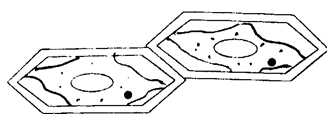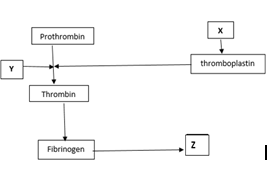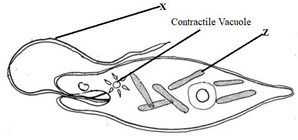Published on October 31st 2023 | 9 mins , 1615 words
1. (a)State two functions of a microscope
- Resolution; Magnification;
(b) Define the term field of view as used in microscopy (1mk)
- A circular area seen when viewing through the eyepiece of a microscope;
2. Study the diagram below showing a portion of an onion epidermis that had been irrigated with a certain solution X.

- Plasmolysed;
b) Describe the process that leads to the condition named above. (3mks)
The cell sap was hypotonic to the solution X; hence the water was drawn from the cell into the solution by osmosis; making the cytoplasm shrink and the cell membrane detach from the cell wall;
3. The following reaction may proceed in the forward or backward direction

Hydrolysis;
(a) In which part of the alimentary canal does the backward reaction occur? (1mk)
Ileum;
(b) Name the enzyme that catalyzes the backward reaction. (1mk)
Sucrase;
4. A certain metabolic pathway takes the following sequence.

(a) At what stage of the reaction sequence did the inhibitor have its effect? (1mk)
At J/between J and K
(a) Explain how the inhibitor affected the reaction. (1mk)
The inhibitor blocked the active sites of enzymes; that convert J to K; hence accumulation of J and near absence of K, L, M, and N;
(b) What is the identity of substance L? (1mk)
Enzyme activator;
5. After fertilization of an ovule, which parts develop into: -
a) Testa (1mk)
Integuments;
a) Endosperm (1mk)
Primary endosperm nucleus;
6. (i) Name the process through which a plant takes up some mineral ions against a concentration gradient. (1mk)
Active transport;
ii) State two factors that may affect the process named in (i) above. (2mks)
oxygen concentration; temperature; enzyme inhibitors; ANY TWO
7. Study the flow chart below which represents a physiological process in mammals

Platelets;
ii) What is the significance of the product represented by Z. (2mks)
Forms a clot; that prevents excessive bleeding/prevents entry of pathogens;
b) Under what condition is thrombokinase released by the platelets? (1mk)
When platelets are exposed to air/ When platelets clump together and adhere to the wall of a damaged blood vessel;
9. (a) Name the nitrogenous waste product excreted by a freshwater fish (1mk)
Ammonia;
b) Explain why a person discharges urine more frequently when environmental temperatures are low than when they are high (2mks)
When environmental temperatures are low, water loss through sweating is reduced leading to an increase in urine output; In high temperatures, water is lost through sweating hence low urine output;
10. Why is it important to use dry mass in ecological studies and not wet mass (2mks)
Wet mass gives inaccurate/inconsistent mass; due to fluctuation of the amount of water in an organism;
11. Identify the agent of dispersal of the following (2mks)
i)Fruits that split open along sutures when dry, hauling their seeds away from the parent plant
Explosive mechanism/self dispersal;
ii) Light seeds with hairy extensions
Wind;
12. a)Name the TWO components of a lipid molecule(2mks)
Glycerol; Fatty acids;
b)State TWO disadvantages of using fats as respiratory substrates (2mks)
Requires a lot/more Oxygen to oxidise; Insoluble in water thus not easy to transport to the respiratory site;
13. a) Name the pigment that protects humans from the negative effect of Ultraviolet lights (1mk)
Melanin;
b) Explain how sunlight contributes to stronger bones and teeth in human beings (2mks)
Needed for the formation of Vitamin D (in the body); Which is required for the absorption of phosphates and calcium ions;( important in bone and teeth formation)
14. Name the main target organ of the following hormones: (2mks)
a) Aldosterone
Kidney;
b) Insulin
Liver;
15. Give THREE features that make modern man to be more adaptable to the environment (3mks)
High level of intelligence/Reasoning/Brain capacity;
Well-developed speech/effective communication abilities; Upright gait to see far/danger easily;
Bipedal locomotion frees hands for other uses; Pre-hensile hands for handling various tools;
Non-opposable toe for stability; 1st 3
15. State TWO contributions of Carolus Linnaeus (1708 – 1778) to taxonomy (2mks)
Came up with binomial nomenclature;
Pioneered Modern/Natural classification/taxonomy;
16 A mother had a still birth and the expelled foetus showed clear signs of anaemia and jaundice a)Give the name of this disorder (1mk)
Erythroblastosis foetalis/Haemolytic disease of the newborn;
b)Describe how the disorder arose (3mks)
Arises when a Rhesus negative mother carries a subsequent Rhesus positive foetus’ pregnancy; particles of foetal erythrocytes pass to the mothers blood leading to formation and accumulation of anti-Rhesus antibodies; which pass to the foetus via placenta causing antibody-antigen reaction that destroy the foetal erythrocytes;
17. The process of gamete formation is represented below

Only X chromosomes are involved;
b) Name the chromosomal mutation represented above (1mk)
Non-disjunction;
c) Identify the genetic disorder that arises when the following gametes are fertilized
i)P (1mk)
Turner’s Syndrome;
ii) Q (1mk)
Klinefelter’s Syndrome;
18. A sample of air was passed through pyrogallic acid and its volume reduced from 8 cm3 to 7 cm3. When it was later passed through lime water, the volume reduced to 6.8cm3.
a) What was the role of pyrogallic acid in this experiment? (1mk)
Remove/absorb Oxygen;
b) Determine the percentage of Carbon (IV) oxide in the sample of air (2mks)
% of CO2 =[(7cm3 – 6.8cm3) X 100] ÷ 8cm3; Deny if Units Omitted
= [0.2 cm3 X 100] ÷ 8cm3
= 2.5%; Deny if % symbol missing
c) Is this sample of air exhaled air or inhaled air? (1mk)
Exhaled air;
19. A zebra is observed to be grazing at a grassland, suddenly a lion appears and the zebra takes off. List two characteristics of living things exhibited by the zebra (2 mks)
Nutrition; Locomotion; Irritability; Gaseous exchange;
Respiration; mark 1st two
20 The diagram below represents an organism. Study it and answer the questions that follow.

Protoctista/Protista;
b) Name the structure labeled X (1 mk)
Flagellum rej Flagella
c) Identify the type of nutrition carried out by the organism and give a reason(2 mks)
Type of Nutrition: Autotrophic
Reason: The organism has chloroplasts
21. A wild beast in Masaai Mara National Park was found to be infested with a lot of ticks. State the trophic level occupied by the following organisms: (2mks)(a)(i)Wild beast: Primary consumer;
(ii)Ticks: Secondary consumer;
(b) Construct a food chain from the above information (1mk)

Ecdysone/moulting hormone; Juvenile hormone;
(b)State the importance of metamorphosis to the life of insects. (2mks)
The adult and larvae exploit different food niche; help the different stages to avoid competition for resources.
Pupa can survive adverse conditions;
23 (a)State two differences between primary growth and secondary growth in woody plants. (2mks)
Primary growth involves the activity/mitotic division of apical meristematic cells while secondary growth involves the activity of the vascular cambium and cork cambium; (of woody parts)
Primary growth results in an increase in length while secondary growth results in an increase in the girth of the stem;
(b) Name two tissues responsible for secondary growth in flowering plants. (2mks)
Cork cambium;
Vascular cambium; Acc cambium alone
24. (a) What is respiratory quotient? (1mk)
Respiratory quotient (RQ) is a ratio showing the relationship between the amounts of carbon (IV) oxide produced against the amount of oxygen used in respiration.
b. Explain why it is difficult to measure respiratory quotient in plants. (2mks)
Oxygen produced (by photosynthesis process) is used for respiration; and the carbon (IV) oxide produced (in respiration) is utilized in photosynthesis;
25. Name one class of phylum Arthropoda with cephalothorax
Class Arachnida
Class Crustacea;
26. A section of nucleic strand contains the following sequence.



Ribosomes
27. (a) What are analogous structures?
Structures with different embryonic origin but have evolved to perform similar functions (due to exploitation of similar niche)
(b) Give two examples of analogous structures in animals (2mks)
Wings of birds and insects;
Eyes of vertebrates and those of molluscs;
Limbs of mammals and those of arthropods; 1st two
28. Name any two sites where gaseous exchange takes place in a leaf of a terrestrial plant (2mks)
Stomata
Cuticle